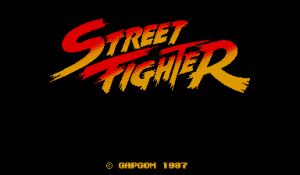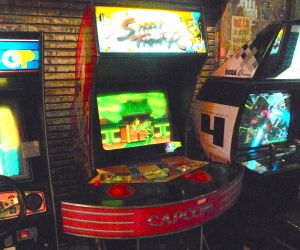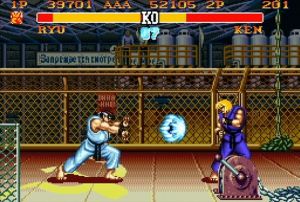A Look Back at Street Fighter from the Beginning

Street Fighter is arguably one of the most popular fighting-game series globally. This game has been entertaining its legion of fans for over 25 years now and it has no signs of slowing down after the recent release of the highly acclaimed Street Fighter V.

When the first installment his the arcades in the late 80's it really was something new and different. There were a couple of different versions, one version had buttons which could sense how hard you hit the button and that would determine a soft medium or hard blow. Other versions had the standard and still used today six button set-up. The controls however did seem to be quite unresponsive, thankfully however, Capcom made major changes both in the graphic and controls when they released Street Fighter II.

The sequel was named 'Street Fighter II: The World Warrior' and it was a massive success. The sequel was a big step up from the first installment because it was a perfect blend of amazing graphics, top notch sound effects, entertaining music and extremely responsive controls. Street Fighter II was groundbreaking as it set precedence for all other fighting-game series. As a fan, I still consider Street Fighter II legendary and special. It was the first fighting game that allowed performing special moves with accuracy and precision.
Street Fighter II is arguably responsible for the popularity of fighting games in the 1990s. Statistics estimate that by 1994 at least 25 million Americans had played this spectacular game. Fans awaited a third installment eagerly. However, instead of a sequel, game developing company Capcom kept releasing pseudo-sequels and updates such as Turbo/Hyper Fighting, Champion Edition, Super Street Fighter II and Super Street Fighter Turbo. This is when Capcom's trend of releasing updates instead of sequels started. Capcom told eager fans that it was taking its time to come up with an epic Street Fighter III. Having enjoyed Street Fighter II to the core, I was anxiously waiting for a superb sequel but the fourth installment was a big disappointment and a rude awakening.It had bad reviews from both gaming magazines and fans globally. Before its official release in 1999, several gaming magazines teased gamers with screen shots of Street Fighter III: New Generation. Fans were stocked and could not wait to play a totally new sequel almost ten years after Street Fighter II. However, most fan reviews were dismal. The complaints included unlikeable characters that were neither memorable nor iconic. I particularly found the characters Necro and Ocro ugly. Fans also complained about the new Parry system. The game introduced characters in the 'arcade' who challenged gamers and proceeded to beat them up which made it hard to proceed with the game.
There were also a ton of other versions of Street Fighter II that made their way into the arcades such as Hyper Fighting, which was a sped up version of the game, and Championship Edition which introduced a few more Characters.
Street Fighter III had a few impressive additions that made it enjoyable, such as the inclusion of Super Arts. The Super Arts move is quite similar to the Super Combo. Another cool addition was the 'Leap Attacks'. This attack move enable gamers to strategically attack crouching opponents. Capcom quickly released updates after Street Fighter III received too many complaints from fans. Street Fighter Alpha/Zero is one of the pseudo-sequels released by Capcom to save face and it was a total blast. Alpha/Zero had a variety of super cool features that gamers adored such as Super Combos and air blocking. These cool features went a long way in making gamers forget the outrageous Parry system in Street Fighter III. The Alpha/Zero pseudo-sequel was very popular that Capcom decided to use it in subsequent crossover fighters. Capcom developed the much loved 'Versus Series' where Street Fighter characters fought against Marvel comic characters such as X-men. Then came 'Capcom Vs SNK' game series where SNK characters such as Benimaro Nikaido from 'King of Fighters' went against Capcom characters. To many gamers this was epic and a dream come true. Game developers continued releasing 'side stories' that received great reviews. Then came the 'Street Fighter EX' games which many fans found clunky and boring. At this time fighting games were being overtaken by sci-fi games in popularity but Capcom changed the game with the reinvigorating Street Fighter IV.
Your browser does not support the video tag.
Street Fighter IV made fighting games cool again. This game reminded every gamer why the street fighter series was legendary . Some of its impressive features included impressive graphics and iconic characters that made the game memorable. Renowned GameSpot editor Dan Chiappino called Street Fighter IV ''undoubtedly one of the finest examples of fighting genre in this generation.'' It was released on several platforms such as PlayStation 3, PlayStation 4, Microsoft Windows, iOS, Xbox360 and Arcade game. Street Fighter IV was quite similar to Street Fighter II. It had a few additions such as 'Focus Attacks' and ultra moves. The Focus Attack is widely popular. This move allows gamers to absorb an attack while simultaneously planning a counterattack. This move is achieved by simultaneously pressing the medium punch and medium kick buttons. Street Fighter IV also has another new cool move called the 'Ultra Combo'. This cool move is a long cinematic move that incorporates kicks, punches and other fighting techniques into one new move.
Your browser does not support the video tag.
There is an 'Ultra Combo' gauge called the Revenge Meter/Revenge Gauge. When performing the Ultra Combo move, the camera shifts from its normal positioning to a cinematic view of the game play. Street Fighter IV had several updates which include Super Street Fighter IV , Super Street Fighter IV: Arcade Edition and Ultra Street Fighter IV. Super Street Fighter IV had some additional characters such as Dudley, Makoto, DeeJay and Ibuki. The Arcade version of Super Street Fighter Iv had new characters such as Yang, Yun, Oni and Evil Ryu. The Ultra Street Fighter IV introduced five new characters , a new announcer and six new stages. It also included an additional feature called the 'Double Ultra Option' and new fighting mechanics.
Your browser does not support the video tag.
With Street Fighter V now released and a ton of DLC content still to come it looks like this series still has a lot of legs.
Tags: Street Fighter V, street fighter, history, retro, arcade


No comments yet. Tell us what you think to be the first.